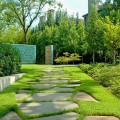Residential Architecture
French Homes
French residential architecture is best supported by an ordered arrangement of shrubs and bushes that convey order and symmetry. The most famous French landscaping design is the parterre garden. Its four-directional cross shape creates pathways of gravel through standing walls of green. From the pedestrian point of view it surrounds the individual with the grounded essence of life. From an elevated vantage point of a balcony or second story window, it maps out the landscape into living quadrants of greenery.
French gardens are derived from this formal pattern but are more scaled down and customized with additional features such as flowering plants and even special grasses. They can be planted anywhere in a yard, whereas the formal parterre garden typically occupies more of a central position to a yard or segregated portion thereof.
Italian Two Story and Townhomes
Italian residential architecture owes much to the Stoic absolutism of the Ancient Roman Empire. The Romans loved structure to the point it became the defining point of their lifestyle. Modern Italian art and architecture are of course, more romantic in essence and a bit more free in form than their Imperial progenitors, but there still remains in many Italian gardens and landscape designs a sense of linearity and angular juxtaposition that establishes clear boundaries and states of separation where different landscaping elements can be focused upon individually and reveled in with great detail.
It is a curious blend of discipline and opulence contained within a form that speaks of acceptance and sanctuary created by a very old and rich culture whose influence has transcended genetic and geographic boundaries as a marker in human thought and artistic development.
Modern and Contemporary Homes
Modern and contemporary residential architecture are all about man and man’s attempt to understand himself in relationship to himself alone. Other paths of awareness and expressions of art position man’s evolution either as the ultimate outcome of progressive natural forces or some wild red herring that suddenly went out of control when he decided to start walking and talking.
Modern landscape design abandons both polarities by attempting to understand man in a world that is strictly mental, cognitive, and abstract. Contemporary landscaping design therefore relies heavily on geometric hardscapes, clear lines, sharp angles, and curious forms of 3D art. Only a marginal splattering of greenery is allowed on a modern landscape due to a point of view that Nature is neither to be coddled or destroyed, but rather somewhat ignored in pursuit of the supremely mathematical and rational.
Colonial Homes
Americans love their history as much as their freedom; and colonial residential architecture reflects this love with a celebration of the stateliness of Old New England Forms and Virginia mansions. During the time of the Colonies, Americans were still fresh out of Europe and therefore looked to Europe for guidance in art, music, literature, and residential architecture.
As a result, Colonial residential design has a great deal of Old World formality inherent to its makeup. However, as with all things American, there is always something of a relaxed sense to the design that comes through in the little things of the landscape. Flower beds do not have to be precise, but they do have to be neat. Trees do not need to be trimmed daily, but they do require maintenance and care. Walls and fountains should rise up more that hug the ground to mirror the archetypal columns that symbolize the whole essence of Colonial forms.
Traditional Americana and the Home of the Simple Life
Traditional residential architecture is more of a feeling and an impression than an exact architectural science. We think of tradition in this country as ways we ought to live–which in a pluralistic culture leaves a great deal of wiggle room for personal belief and expression.
However, there are some things that seem universal to almost every citizen of our land, and these are the things that are subliminally represented by the keynotes residential in traditional architecture. More than anything you might call this the beauty of simplicity and practicality with a touch of conservatism that is also curiously insistent on the option of free thinking at the drop of a hat.
As such, the landscape designs that support traditional residential architecture consist of very basic elements like gardens, pools, fountains, flower beds, patios, and decks. The uniqueness comes from the consultation where actual materials and arrangements of such things are determined by the personal values and tastes of the homeowner.


